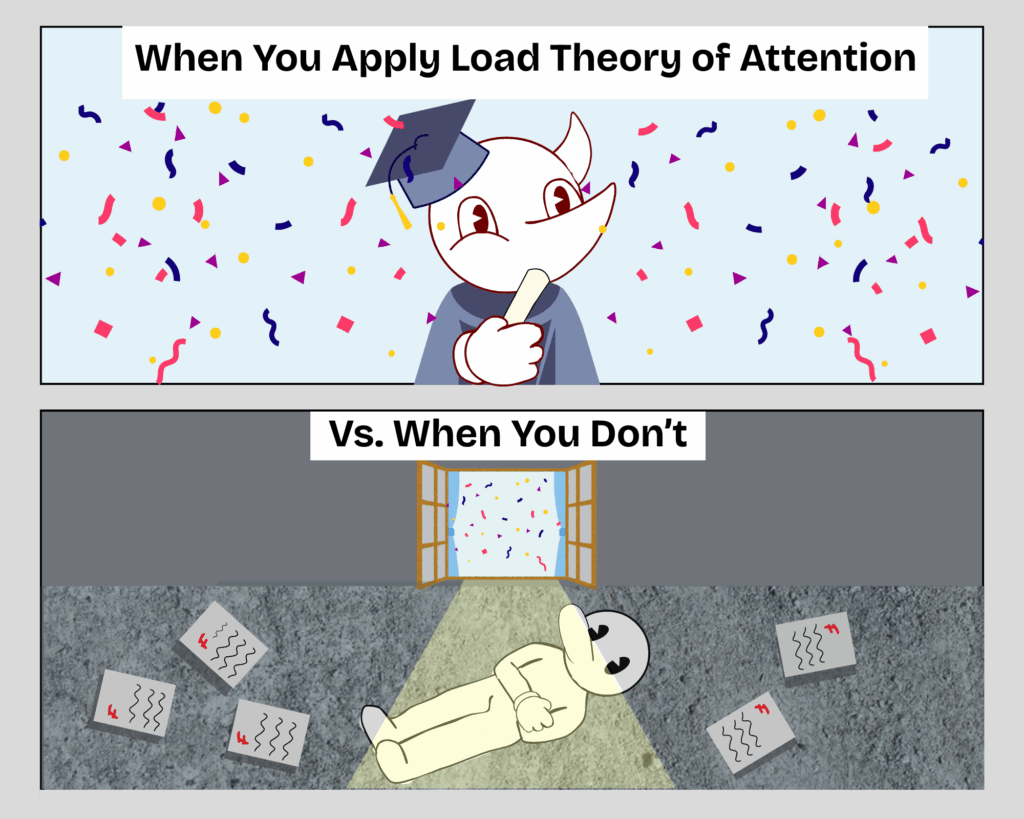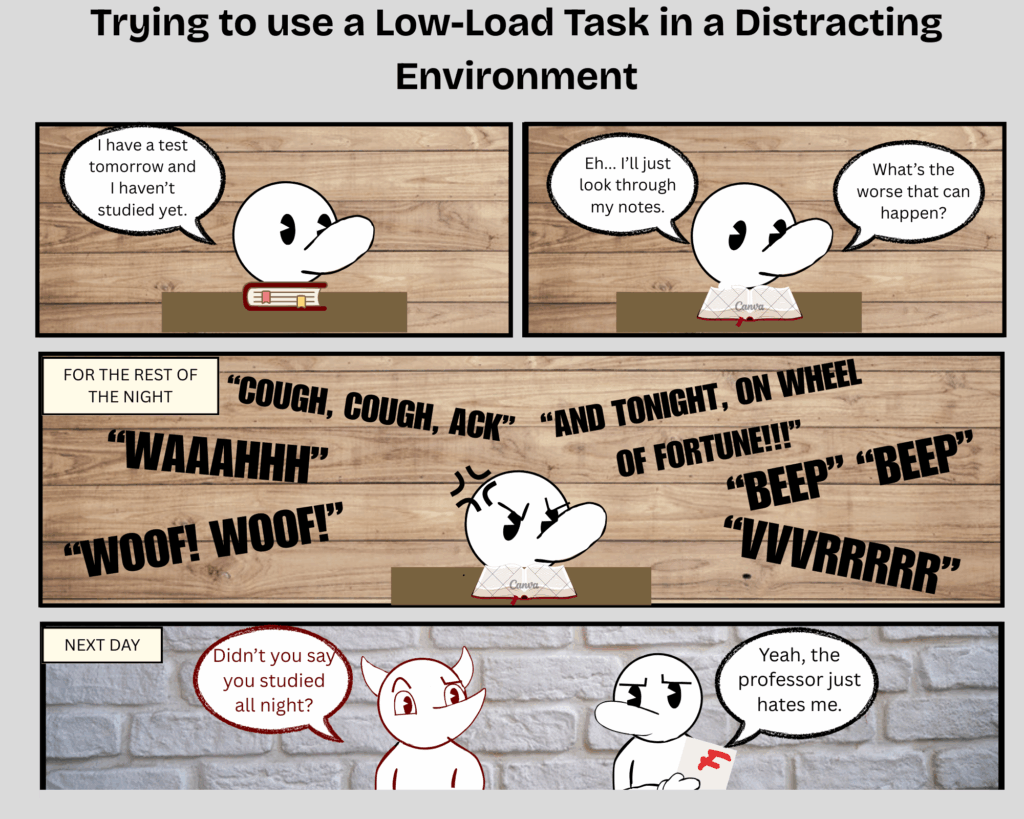By Bailey Newhouse

Intro:
Have you ever noticed that, when you are working on a tough homework assignment, the world shuts down around you? You become hyper-focused on the task in front of you that you barely register someone coughing a few feet away from you or the sound of music playing through your headphones. However, when you pull out your phone and start watching Tik Tok, suddenly every single noise is audible. The person talking loudly across the room, the sound of someone getting out of a chair, the person coughing from early, all of it begins to distract you from your daily doom scroll. Why is that? Well, you may be experiencing something called load theory of attention, and when it comes time to study for those college exams, it may be something you want to be aware of.
Load Theory of Attention
But first, what is the load theory of attention? Load theory of attention is the idea that we are able to ignore certain distractions, like the person coughing from the previous example, depending on how much mental attention the task we are doing requires [1]. If we are focused on something that requires a lot of mental attention or concentration, then we tend to block out certain distractions in our environment. However, if we are engaged in an activity that doesn’t require a lot of concentration, then we tend to be more susceptible to distractions [2]. For example, if you’re studying a hard subject in the living room, then you tend to ignore the things going on around you, like the TV in the background or the sound of cars passing by outside. However, if you are studying for an easier class and are simply flipping through the notes, then the TV is more noticeable.
But why does this happen? Well, it comes down to the amount of processing capacity a task asks of you.
Processing Capacity: High vs. Low Tasks
While the word sounds complicated, it’s very simple. Processing capacity is how much information our brains can handle at a time [1]. Some tasks require more processing capacity while others do not. Those that require more are categorized under high-load tasks, which would be things like Shakespeare readings, practicing for a presentation, or taking an exam. These are things that require a lot of your attention, and you can only understand these things when you give your full attention, otherwise you will feel overwhelmed [2]. Meanwhile, things like flashcards, light reading, and memorization by simply looking at your notes or study guide would fall under low-load tasks, things we are able to do without much thinking or concentration [1]. A risk of low-load tasks is that you are more susceptible to being distracted by things outside the task. So rather than staring blankly at your notes to study, a better method would be to turn those notes into a high-load task or something that requires more attention. Some examples are taking your notes and creating a series of complex flashcards, highlighting parts of your textbook or a website you’re reading and writing a summary of what you read, or creating mini quizzes from your notes. These all require a lot of thinking and attention and will ensure you’re more likely to remember that information for an upcoming exam rather than mindlessly flipping through your notes, staring absently at your study guide, or putting your notes through ChatGPT and having it passively summarize information for you.
However, it’s important to know that low-load tasks have their place too. It’s not bad to look at flashcards, your study guide, or your notes, However, there’s a time and place to engage in low-load tasks and high-load tasks. It’s just knowing when and how to implement which. If you are in a distracting or loud environment, doing high-load tasks will be much more beneficial than doing low-load tasks [2].
Implementing Load Theory of Attention for Success
Now that you know what load theory of attention is, here are some ways you can implement this idea into your study habits for college.

Turn Low-Load Tasks into High-Load Tasks:
As mentioned previously, turning low-load tasks into high-load tasks decreases the risks for distractions getting in the way of studying. Try turning your vocab lists into a mini quiz, writing a summary of your textbook or an online article rather than simply reading through it, or creating a visual example of a concept from your notes rather than just reading the definition over and over again till you memorize it. These techniques can help you study material in a loud or distracting environment and allows you to actively engage with the material, which is proven to help with memorization, even for the hardest of material [3].
Avoid Doing Too Many High-Load Tasks at Once:
Doing too many high-load tasks can overwhelm you and cause you to burn out or forget what you’re studying [4]. Take 15 to 30 minute breaks in between studying to not overexert yourself. Engage in small but meaningful tasks during these breaks such as reading a book, taking a walk around campus, eating, drinking water, or cleaning your study area if it gets messy. As they say, a clean space makes for a clear mind.
Find or Create a Distraction-Free Zone:
If you are partaking in a low-load task, the best way to fully engage with that task is by creating a distraction free zone. Libraries are great for this, and most colleges offer quiet study rooms you can use. But, if the library is too crowded or all the study rooms are full, you could always turn your dorm room into a study room. Turn your TV off, put your phone on silent and far away from your study, either in a drawer or another room, and if you are unable to handle sitting in silence for hours at a time, put on noise cancelling headphones and play either orchestra music or white noise on your laptop. Some people need a mix of low-level tasks to stay engaged, and that is okay as long as the low-level tasks do not build up too much to be overwhelming and distracting [5].
Have a Balance of Low-Load Tasks and High-Load Tasks:
While high load tasks are great to do in a busy environment, they do not always result in the best outcomes [5]. Doing only high load tasks can be mentally draining, so try having a balance of both types of workloads. That way you can save your low-load tasks for your room and your high-load tasks for those loud environments like the cafeteria or when working in the hallways during passing periods.
Conclusion
College is always seen as this exciting yet intimidating part of one’s life. On one end, you have the parties, clubs, and opportunity to make lifelong friends, but on the other, you have 11 assignments, 3 exams, and 5 essays all due on Canvas at 11:59pm. How can one balance it all? While I can’t give you advice on all the fun stuff, I can give you advice on the assignment part of college. If you just implement load theory of attention into your daily study habits, you will be on the road to success. It’ll be hard at first, as developing any routine is, but once you do, you’ll find that nothing will ever distract you from your goals again.
[1] Lavie, N., Beck, D. M., & Konstantinou, N. (2014). Blinded by the load: attention, awareness and the role of perceptual load. Philosophical Transactions: Biological Sciences, 369(1641), 1–10. JSTOR. https://doi.org/10.2307/24500065
[2] Lavie N. (2010). Attention, distraction, and cognitive control under load. Current Directions in Psychological Science, 19(3), 143-148. JSTOR. https://dio.org/10.1177/0963721410370295
[3] Wankat, P. (2015). Active learning. Teaching Engineering, 2, 145–184. Purdue University Press. https://doi.org/10.2307/j.ctv15wxqn9.11
[4] Paas, F., G. W. C., & Van Merriënboer, J., J. G. (1994). Instructional control of cognitive load in the training of complex cognitive tasks. Educational Psychology Review, 6(4), 351–371. JSTOR. https://doi.org/10.2307/23359294
[5] Zhu, B., & Watts, S. A. (2010). Visualization of network concepts: the impact of working memory capacity differences. Information Systems Research, 21(2), 327–344. JSTOR. https://doi.org/10.2307/23015536
Hello Bailey,
I appreciate how you utilize common examples to illustrate the idea of high and low load task. It’s so true that when we are highly engaged in challenging work, distractions go into the background, but the moment we shift to something less demanding, our attention can very easily be distracted.
Your suggestion on how to turn low load task into high load tasks are useful. I appreciate the way you highlighted the necessity for a balance between the high and the low load task. It is a nice reminder that although we need to challenge ourselves, we also need to avoid burnout by pacing our studies.
I especially enjoy the idea of establishing a distraction free are, and is something I will put into practice immediately. It’s so easy to be distracted by our phones or background noise, especially in a dorm setting. In total, this a great post for anyone looking to improve their studying. I’m excited to try these methods out in my own study routine. Keep doing what you’re doing!!!!!
Mhill22
I’m glad you enjoyed my blog post and will be utilizing some of the techniques I described. While doing high-load tasks are a great way to tune out distractions, they do require a lot of mental attention and can easily lead to burn-out if over utilized. So, that is why I mentioned the importance of utilizing both low-load tasks and high-load tasks rather than one or the other. You will have to let me know if some of the techniques worked for you or if you were able to find new or better techniques using load theory of attention.